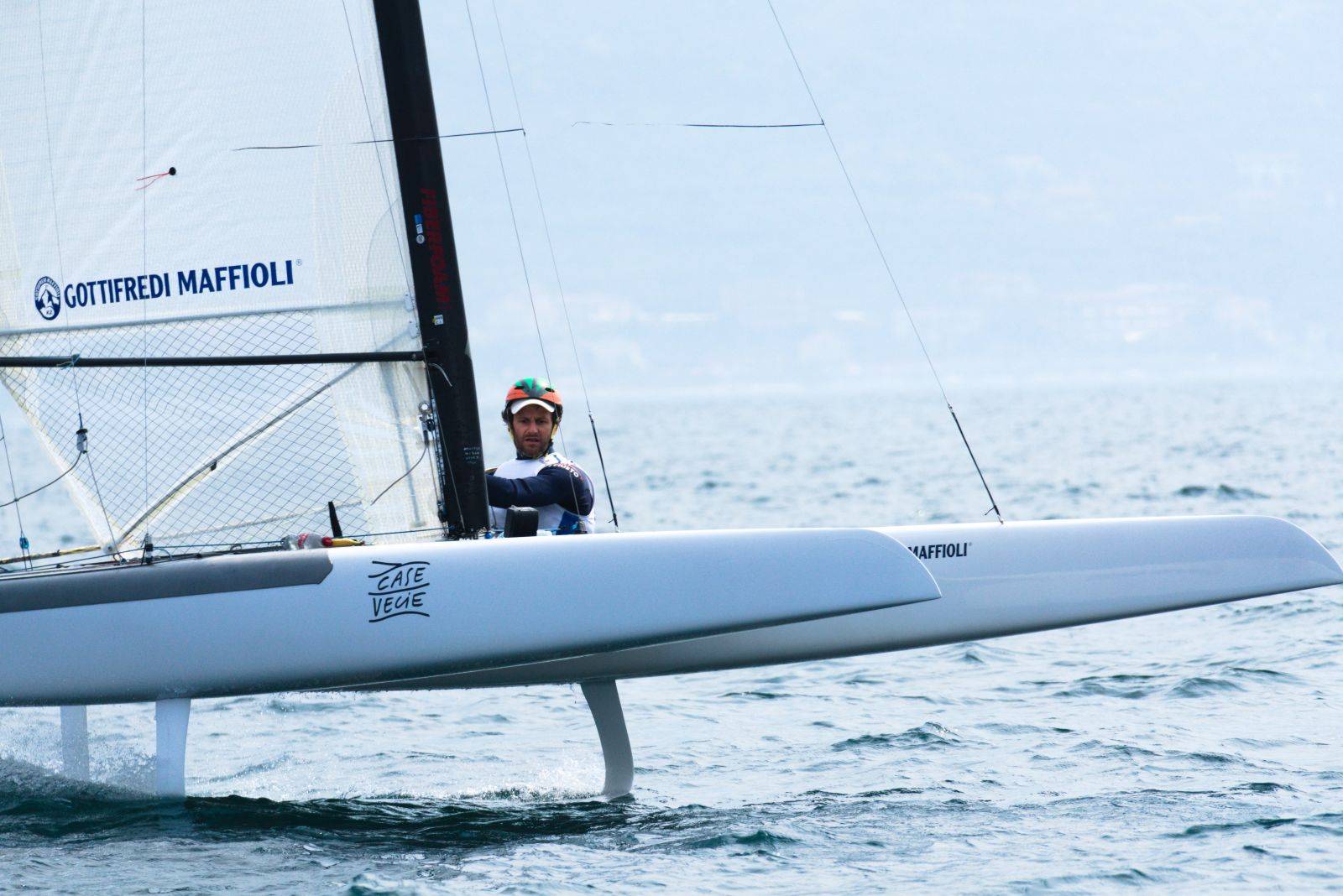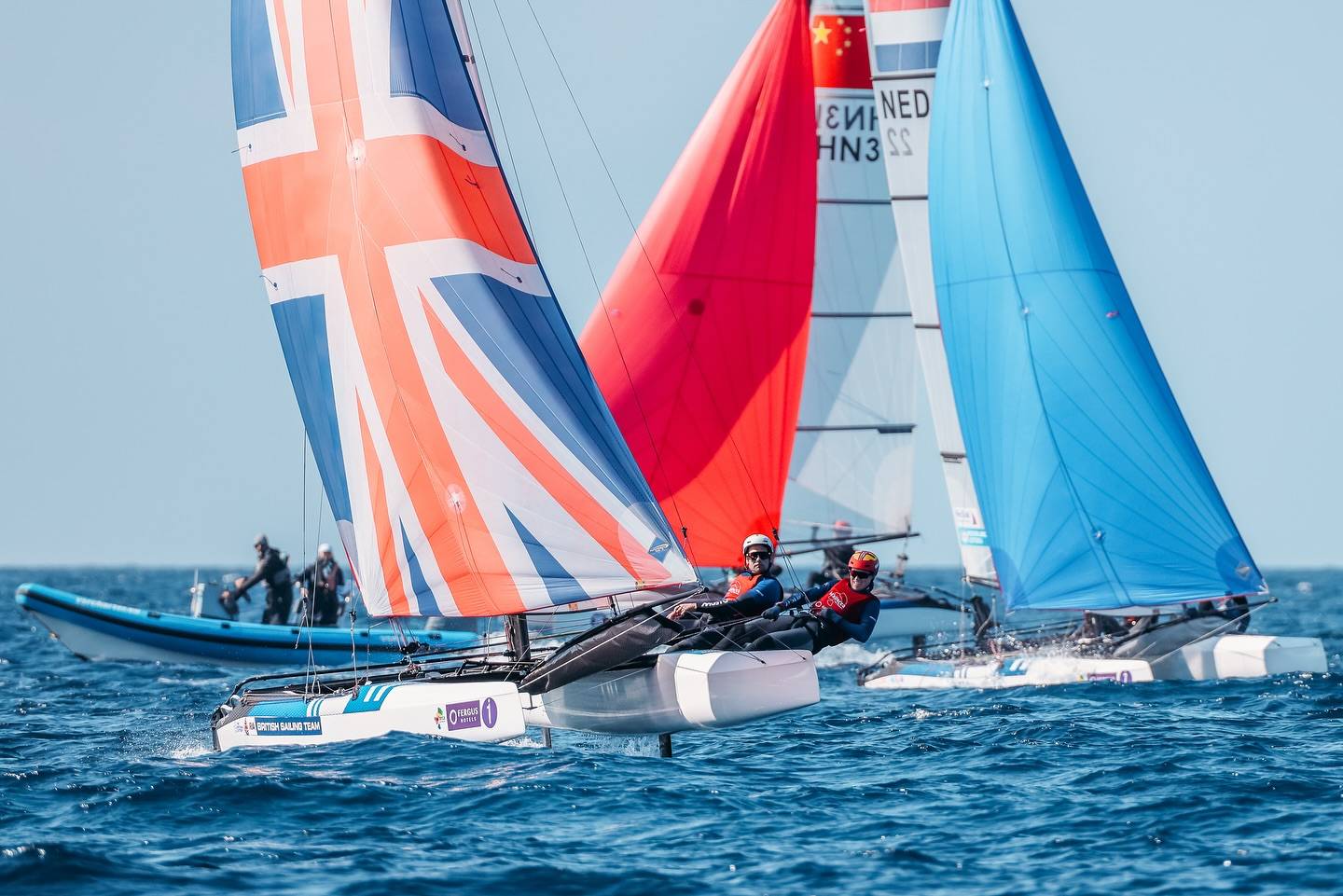A-Class Europeans 2012: Landy’s Report
Photo: Dominik Scheurer.
Mailed some questions to Landy and he sent back a full report on the event.
He speaks about the importance of the start and I saw at the live broadcast from Aarhus Worlds how he dominated the start holding the boat at will and even taking out some guys out from that ‘steady’ position. For many of us in the local F18 fleet will be a challenge at next Worlds, as starting with 100 boats it is agame changer, although I always try to practise going 1 minute to the line.
Also interesting remark on the supply that creates demand as that what happened here in Arg with the F18, I posted once “Build it and they will Come”.
Great report with lots of data from a class that seems to have to limit on its future growth. He jsut missed to answer on the rudders Winglets (see photo above) he have been using for a while now. If you have report of your own from the Europeans send it.
—————-
 |
| Photo: Roberto Vuilleumier |
Report By Andrew Landenberger
Conditions were quite variable across the course. On the rock wall there was generally always more wind with the potential to be quite strong in the gusts so you needed to keep your eyes open. Basically it was typical lake conditions with a lot of geographic influence, so you had to follow the road map and make a few quick decisions if you arrived somewhere at the wrong time.
Not difficult to work out but you had to be ready to cut your losses quickly and get back in the game. Generally we had no shortage of wind, just one race was abandoned on the final lap when the wind just evaporated.
I would say my success started with very good starts.
I got away cleanly every day exactly where I wanted to be. Holding the boat correctly on the line is very important and that is something I have always put a priority on practice. Having confidence on the line is very important. To make it easier I had no shortage of speed. Upwind I was always safe. There was always someone around going fast but I always felt I could control the situation.
Downwind I was very fast – I guess this is where I could always make the jump when I had to. Normally I am always pushing for the trapeze downwind but found also very good speed sitting in. It just depended on the tactical situation at the time which way to go.
In the right conditions the trapeze is the way to go, but I would say it is not for everyone. I have spent most of my life hanging around on a trapeze so for me if comes easy. Those who do not feel confident out there would go faster sitting in. I think Scott has proven that he can hold his own staying off the wire so it is not that you can’t be competitive. It is just practise like always.
Generally I would say I was pretty confident with my position, but at the same time Chris and Brad were close by and I had a lot of respect for the others. Things could have changed very quickly in the races and it was only after day 3 that it was clear the others had a very tough job in font of them to catch me. On day 4, I only needed a safe result so I settled for a 4th in heat 7 and took no risks. As it turned out that was already enough to secure the championship. I sailed heat 8 and took another 4th but I already new the job was done, so it was a pretty relaxed day on the water.
The new G6 is excellent. I have been working with Andy Scheurer for several years and his hard work has finally paid off. We have been “Step by Step” developing the boat with small changes to make the package as perfect as possible. In brief, we moved the beams back, adjusted the hull volume to suit and moved the centreboards back further to allow us to carry more rake for the downwind and still keep the boat in balance upwind. There were also new centreboards, rails on the gunwales to increase the leverage on trapeze and all the new boats are now built from nomex. The end result has been a very high quality product which I am very happy to be sailing.
I chose to use the Maxx kevlar sail, only because of the mast. I made a commitment to Piet Saarberg that I would use his mast in this regatta and as it turned out this mast was slightly stiffer than my Fiberfoam and DNA mast. As it turned out the Maxx sail was the one I had in the trailer with the flattest luff curve.
Clearly both sails are very fast, but the key point is to match the mast sail combination. I was actually planning to use the membrane and I had sails in the trailer which were built for DNA masts and also sails for the Fiberfoam mast.
 Both these combinations I had tested earlier and I new were fast. I was a little late getting organised on the Saarberg mast as it turned out to be a little stiffer than I was expecting, but with the Maxx sail it was fast enough across all conditions so I just stuck with it. It is always a point of contention with the customers which sail I choose to race with but since we offer the full range I simply have to choose one and use it.
Both these combinations I had tested earlier and I new were fast. I was a little late getting organised on the Saarberg mast as it turned out to be a little stiffer than I was expecting, but with the Maxx sail it was fast enough across all conditions so I just stuck with it. It is always a point of contention with the customers which sail I choose to race with but since we offer the full range I simply have to choose one and use it.
Perhaps next time I will use the membrane. I was extremely impressed by the speed of the guys using these sails so I believe there is a strong future in this type of sail construction. It seems the customers agree as the orders have been rolling in, since the Europeans.
The Class keeps going from strength to strength. They are just a great boat which has a lot to offer. No crew problem is one strong point, but also the boats are now a very high quality and although they are a construction class, the developments are happening in small steps.
The Nikita has been around for probably 10 years now and is still one of the fastest boats in the fleet. The fast that small development keep coming creates a good second hand boat market which allows people to enter the class at an affordable level and still be very competitive.
Also the success of the DNA should not go un-noted. PJ and Arno have done a fantastic job or getting a lot of boats on the water in a very short time. I would say Ronald Reagan’s economic theory that Supply creates it’s own demand has been proven to be true. We have had a lot of new people come to the class simply because it has been easy to order a boat with very short delivery times.
I think the other builders are also still running like usual so in all it has been a very positive period for the class.
I spend most of the year in Australia where I design sails and help my Parents run our sheep and cattle property. It is not exactly the wild west, but we seem to always have some action going on there. I used to think it was all good fun but it seems i don’t bounce like I used to.
I was unlucky to have two accidents close to each other. the first one was machinery related where i broke some ribs. Two weeks later I was on a young horse I have been training, and he decided to stick it into me. After a battle the girth strap broke on the saddle and I did the full cartwheel over the front.
 I came down hard on the pelvis which I broke and did some damage also to the lower back. I was in the bed for 6 weeks and it took a long time just to get the feeling back in the right leg. It really did not look like it was a chance to sail the Euro’s, as I could not even walk for the first month. My Doctor just laughed at me when I told him my plans. The first time I sat on the boat was the Alpen cup on the 9th June. I remember sailing to start thinking to myself – what am I doing here?
I came down hard on the pelvis which I broke and did some damage also to the lower back. I was in the bed for 6 weeks and it took a long time just to get the feeling back in the right leg. It really did not look like it was a chance to sail the Euro’s, as I could not even walk for the first month. My Doctor just laughed at me when I told him my plans. The first time I sat on the boat was the Alpen cup on the 9th June. I remember sailing to start thinking to myself – what am I doing here?
I sailed 12 days straight after that just forcing everything to work again. It is nothing I want to go through again – but my horse is at home waiting for me so he will get a good talking to next week!
Next event for me is the worlds In Florida. It is winter in Australia at the moment so it is a quite period for the wind and regatta’s. I will probably spend more time rowing and discussing life with my horse.
Attached is “Spike the horse”
Best regards,
Landy
————
Catsailinews.com


























I just heard that my great sailing friend and former CEO of Hobiecat Europe has passed. May The endless oceans…
...Report was sent by an F18 Sailor, if you want Hobies reported send your own, we'll publish as usual. Cheers.
Looks like in your report the Hobies are not really present. Suggest to rewrite the article.
Thanks for the great report Wik. Great battle.
If I correctly read the results the overall winner this year is a Hobie16